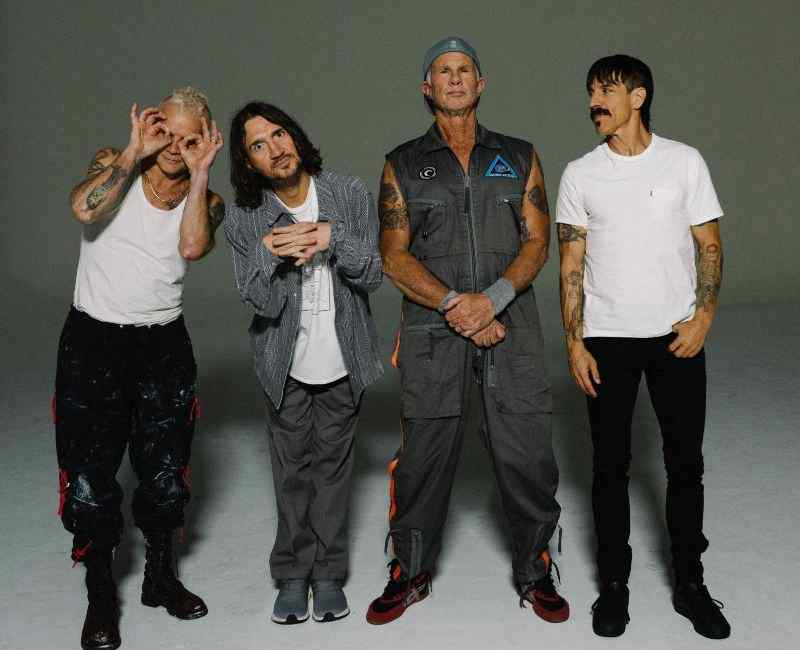From raucous punk rawness to conceptual prog escapism, bands that start with the letter “R” have left an indelible impact across the rock landscape. The Rock and Roll Hall of Fame would undoubtedly need a separate wing to showcase all the diverse sonic pioneers bearing the distinguished “R.”
Tracing the evolution of bands like Radiohead and R.E.M reveals revolutions in guitar rock unfolding in real-time. The brash DIY ethos of Ramones lives on in disruption-hungry acts like Rage Against the Machine. The allure of Roxy Music’s avant-art glamour still echoes in flamboyant performers today.
Even the pop mastery of Roxette or the stadium-filling might of Rush remain unequaled. These artists may vary wildly in sound and persona, but ingenuity binds them together. Expect the unexpected – and usually incendiary – from bands that lead with “R.”
| Band Name | Origin | Genre | Notable Albums | Key Members |
|---|---|---|---|---|
| Radiohead | Oxfordshire, UK | Experimental rock | OK Computer, Kid A, In Rainbows | Thom Yorke, Jonny Greenwood, Ed O’Brien |
| Red Hot Chili Peppers | Los Angeles, USA | Funk rock, alternative rock | Blood Sugar Sex Magik, Californication, Stadium Arcadium | Anthony Kiedis, Flea, John Frusciante, Chad Smith |
| R.E.M. | Athens, Georgia | Alternative rock, jangle pop | Murmur, Document, Automatic for the People | Michael Stipe, Peter Buck, Mike Mills, Bill Berry |
| Ramones | New York City | Punk rock | Ramones, Road to Ruin, Too Tough to Die | Joey Ramone, Johnny Ramone, Dee Dee Ramone |
| Rush | Toronto, Canada | Progressive rock, hard rock | 2112, Moving Pictures, Clockwork Angels | Geddy Lee, Alex Lifeson, Neil Peart |
| Rage Against the Machine | Los Angeles, USA | Rap metal, funk metal | Rage Against the Machine, Evil Empire, The Battle of Los Angeles | Zack de la Rocha, Tom Morello, Tim Commerford |
| Roxy Music | London, UK | Art rock, glam rock | Roxy Music, For Your Pleasure, Avalon | Bryan Ferry, Brian Eno, Phil Manzanera, Andy Mackay |
| Rammstein | Berlin, Germany | Industrial metal, NDH | Sehnsucht, Mutter, Reise, Reise | Till Lindemann, Richard Z. Kruspe, Paul Landers |
| Rancid | Berkeley, USA | Punk rock, ska punk | …And Out Come the Wolves, Life Won’t Wait, Indestructible | Tim Armstrong, Lars Frederiksen, Matt Freeman |
| Roxette | Halmstad, Sweden | Pop rock, power pop | Look Sharp!, Joyride, Crash! Boom! Bang! | Per Gessle, Marie Fredriksson |
[recommended_posts posts=”1897,1849,1877,1893,1930″]
10 Best Bands That Start With R
1. Radiohead

Radiohead is one of the most critically acclaimed and genre-defying bands of the last 30 years. Formed at an all-boys school in Oxfordshire, England in 1985, their experimental sound and deeply introspective lyrics have made them hugely influential.
How did Radiohead’s experimental and genre-defying sound evolve over the years?
Starting as more of a standard guitar rock band, Radiohead began incorporating electronic elements and unusual instrumentation into their music over time.
Their third album OK Computer marked a major shift, with complex song structures and conceptual, dystopian themes. Subsequent albums like Kid A embraced avant-garde electronica, with the band completely reinventing their sound and leaving mainstream rock behind.
Even their later guitar-centric works feature unexpected time signatures and chord changes – like on In Rainbows, which opens with the off-kilter rhythms of “15 Step.” Radiohead has continuously subverted expectations and explored new sonic territory with each release.
What were the themes and influences behind their conceptual and introspective lyrics?
Radiohead’s lyrics grapple with feelings of alienation and anxiety in the modern world. Their songs criticize consumer and corporate culture, technology, politics, etc. Lead singer Thom Yorke draws inspiration from dystopian authors like George Orwell and Kurt Vonnegut, who influenced his skeptical worldview.
Their music also channels more interior struggles with depression and fame. Albums like OK Computer depict technologically overloaded modern life, while Kid A’s abstract lyrics reflect Yorke’s mental state. Their conceptual, fragmentary lyrics offer revealing windows into the band’s emotions.
How did their innovative music videos and visual aesthetics enhance their artistic vision?
Director Jonathan Glazer’s iconic video for “Karma Police” captured the rebellious strangeness of OK Computer’s sound through provocative imagery.
For Kid A and Amnesiac, artist Stanley Donwood’s cryptic paintings and graphics complemented the unsettling musical shift. Radiohead also worked with indie filmmakers like Michel Gondry, using bold visuals to amplify their music’s emotional power.
Their album art and music videos are now considered landmarks for their innovation – like the politically satirical short film accompaniment to “Burn the Witch.” Radiohead’s creative visual expressions expand on their sound’s intensity.
2. Red Hot Chili Peppers

The Red Hot Chili Peppers blended rock with funk, rap, and punk influences to create an energetic, unique sound. Formed in 1983 in Los Angeles, their charismatic frontman Anthony Kiedis and bassist Flea were childhood friends who brought infectious energy and showmanship to the alternative rock scene.
What was the significance of Red Hot Chili Peppers’ fusion of funk, rock, and rap?
At a time when guitar rock dominated, the Chili Peppers offered a refreshing change of pace with their melding of styles. Flea’s popping basslines had the verve of funk greats like Bootsy Collins, contrasting with singer Anthony Kiedis’ rapid-fire rap delivery.
Kiedis could shift from fiery punk intensity to smoother R&B phrasing. Their hybrid sound opened the door for more stylistic cross-pollination in 90s rock. Songs like “Give It Away” became blueprints for feel-good party anthems built on funk foundations. Their eclecticism paved the way for nu-metal and fusion acts.
How did their energetic live performances and stage presence contribute to their success?
The band quickly gained notoriety in LA for their unpredictable, thrill-seeking concerts. Kiedis often performed shirtless, executing daredevil moves onstage. Their shows had a reckless, anything-goes vibe, with impromptu jams and covers.
Over time their musical prowess improved to match their showmanship. Surprising covers and odd instrumentation kept fans guessing – like their performance on The Simpsons flanked by a mariachi band. Their chemistry and enthusiasm made their concerts legendary parties. Fans couldn’t help but be swept up.
What were their most commercially successful and critically acclaimed albums?
1991’s Blood Sugar Sex Magik catapulted them into the mainstream, powered by hits like the anthemic “Under the Bridge.” It perfectly balanced their raw energy with the expanded sonic palette.
John Frusciante’s guitar playing added new depth. 1999’s Californication marked a resurgence for the group, proving highly influential on nu-metal bands.
Stadium Arcadium also garnered a Grammy. Over the years, critics consistently praised their musicianship, despite initial perceptions that they were pure party animals. Their sales and critical recognition grew hand in hand.
3. R.E.M.

R.E.M. rose out of the vibrant 1980s college rock scene in Athens, Georgia to define the genre with their jangly guitar-pop sound and socially conscious lyrics. Frontman Michael Stipe’s introspective, poetic vocals and enigmatic personality made them alternative icons.
How did R.E.M.’s jangly guitar sound and introspective lyrics define college rock?
Peter Buck’s bright, clear guitar style conjured the signature college rock mood – earnest and melodic, but with an edge. Stipe’s murmuring vocals and words of disaffection connected with student audiences. Tracks like “Radio Free Europe” and “The One I Love” were like bittersweet campus anthems.
The texture of R.E.M’s early records embodied the independent spirit of college radio stations across America. Labels like I.R.S. Records and fanzines like CMJ New Music Report championed them among other rising college rock bands.
What were the themes and influences behind their socially conscious songwriting?
R.E.M. wrote about political issues and challenges facing Generation X with empathy and nuance. Stipe’s poetic sensibility added richness to their commentary on topics like the environment, poverty, and LGBTQ rights.
Their outsider perspective resonated with youth culture. Records like Document tackled injustice and corruption head-on, while later works like Automatic for the People turned inward with tales of grief and loss.
As the band matured, their songwriting encompassed more complex emotional landscapes – touching on depression, mortality, and nostalgia. But even their saddest songs contained glimmers of hope about human resilience. R.E.M. maintained a conscience even as their stardom grew, acting as a moral voice for Gen X.
How did their sound evolve from their early days to their later, more experimental works?
Their early records had an enigmatic college rock feel, with fuzzy guitars and Stipe’s murky vocals blending hypnotically. As they progressed, their songwriting became more sophisticated and diverse – from mandolins on “Losing My Religion” to the electronic textures of Up.
Later albums like Reveal embraced lush atmospherics and string arrangements. Kaleidoscopic final album Collapse Into Now encapsulated their adventurous journey into icon status.
However, trace elements of their signature sound always persisted – like Peter Buck’s chiming riffs and Stipe’s introspective intensity. R.E.M. grew exponentially while retaining its core personality.
4. Ramones

Beloved punk pioneers the Ramones boiled rock down to its simplest elements – delivering buzzsaw guitar riffs and teenage rebellion anthems. Formed in Queens, New York in 1974, their raw energy and attitude provided a blueprint for both punk and metal bands.
What was the impact of the Ramones’ raw and simplistic punk rock sound?
The Ramones demystified the idea that rock music had to be complex or virtuosic. Their songs typically featured just a few power chords and machine-gun drumming. Many clocked in around two minutes long. But their formula was wildly effective – delivering cathartic, adrenaline-surging punk anthems.
Tracks like “Blitzkrieg Bop” and “Sheena is a Punk Rocker” became rallying cries for misfits and rebels. Their stripped-down sound inspired both the punk and metal genres by proving technical ability wasn’t a prerequisite for impact.
How did their rebellious attitude and image resonate with fans?
With their leather jackets, ripped jeans, and disaffected poses, the Ramones personified punk rebellion. Most memorably, Joey’s signature mop haircut became an enduring symbol. Their shared pseudonym “Ramone” emphasized their outsider status.
Songs like “Beat on the Brat” and “Pinhead” channeled frustration with a biting, sarcastic humor that spoke to alienated youth. Their take-no-prisoners approach made catharsis feel within reach of outcasts. Fans latched onto the Ramones as larger-than-life figures representing liberation from societal constraints.
What were their most influential and iconic albums?
Their 1976 debut album Ramones set the template for punk with buzzing singles like “Blitzkrieg Bop.” Rock ‘n’ Roll High School’s title track became a rebellious teen celebration. Road to Ruin showed their songwriting growing more sophisticated alongside their formulaic core sound.
Too Tough to Die saw them return to hardcore punk roots with renewed focus. Even in later decades, their formula remained reliable on records like Brain Drain – proving the timelessness of their attitude when many punk peers had burned out or faded away.
5. Rush

Rush wowed audiences with their dazzling displays of musical virtuosity and heady, sci-fi-influenced concept albums. Formed in 1968 in Toronto, Geddy Lee’s unusual high register vocals and Alex Lifeson’s cerebral, classically-inspired guitar playing made them stand apart from many hard rock peers.
How did Rush’s blend of progressive rock and heavy metal set them apart?
Most bands fell cleanly on the side of metal or prog at the time – but Rush fused these two typically opposing styles seamlessly. Their songs had the complexity and fantasy themes of prog epics but with the crunch and heaviness of metal. Geddy Lee’s synth rig let them explore unusual textures not common in the genre of the era.
Their otherworldly time signatures and labyrinthine arrangements were underpinned by a rock-solid foundation capable of radio-ready rock anthems too. Their dazzling musicianship elevated them above typical metal rawness.
What were the conceptual themes and narratives behind their epic albums?
Records like 2112 and Hemispheres unfold almost like sci-fi or fantasy novels – spinning conceptual tales across multiple song suites. Their songs grapple with utopian/dystopian themes, battle tyranny and oppression, and muse about self-determination and human potential via allegory.
Albums like Clockwork Angels contained full-blown steampunk narrative universes. Their cerebral, speculative lyrics offered escape while still engaging the mind. References to philosophy and literature reward closer listening as well.
How did their virtuosic musicianship and complex compositions inspire other bands?
Neil Peart set a new standard for rock drumming with his elaborate parts and mammoth drum kits, integrating jazz and big band techniques. Alex Lifeson’s intricate guitar playing encompassed baroque classical influences alongside rock bombast.
Geddy Lee’s vocal range and bass skills awed aspiring musicians. Prog metal bands like Dream Theater directly emulate their musicianship and conceptual scope. Even grunge champions Nirvana cited them as influences for expanding notions of what rock could be. Their technical finesse opened new possibilities for rock music.
6. Rage Against the Machine

Rage Against the Machine channeled revolutionary spirit through their intense fusion of rap, metal, and funk – delivering politically charged barnburners. Formed in 1991 in Los Angeles, their aggressive sound provided the ideal vehicle for frontman Zack de la Rocha’s fiery activism.
What was the significance of Rage Against the Machine’s fusion of rap and metal?
On paper, rap, and metal seem incompatible. But Rage welded these rebellious genres together more effectively than any act before – channeling metal’s cathartic aggression through hip-hop. Tom Morello’s metallic riffs interlock fluidly with Tim Commerford’s funky basslines – allowing De La Rocha’s revolutionary lyrics to take center stage.
Morello’s innovative use of guitar effects added new sonic wrinkles. Their bombastic rap-rock synthesis empowered radical messages to spread widely. Rage showed rock could still be dangerous and subversive in the post-80s environment.
How did their politically charged lyrics and activism resonate with fans?
De La Rocha’s scorching delivery made their radical politics feel thrillingly urgent. His takedowns of systemic inequality, corporate greed, government overreach, and imperialism resonated with disaffected youth. Rage performed at the 2000 DNC in protest of both political parties.
Their activism backed up their rhetoric – like protesting exploitative prison labor by staging a concert outside California’s San Quentin. Fans were galvanized into action by their messages.
What were their most influential and groundbreaking albums?
Their 1992 self-titled debut crystallized their revolutionary vision – with confrontational tracks like “Killing in the Name” and “Take the Power Back.” 1996 follow-up Evil Empire continued lambasting establishment corruption and societal ills.
After a long hiatus, they returned re-energized on Renegades – a covers album reinventing protest-themed songs by Bob Dylan, Bruce Springsteen, and more through a Rage lens. Their first two albums especially sent shockwaves by weaponizing rap and metal as political tools.
7. Roxy Music

Art rock pioneers Roxy Music explored avant-garde sounds and visuals – cladding experimental musical ideas in glamorous packaging. Formed in 1970 by art school classmates Bryan Ferry and Brian Eno, their artsy eccentricity infiltrated the pop mainstream.
How did Roxy Music’s blend of art rock, glam rock, and experimental styles define their sound?
Roxy Music’s records showcase their far-ranging influences – from psychedelia to 50’s rock n’ roll to electronic ambient music. Bryan Ferry’s crooning vocals channeled old-school romanticism, contrasting imaginatively with Brian Eno’s analog synthesizers.
Guitarist Phil Manzanera’s glam-inspired playing linked it cohesively, while saxophonist Andy Mackay added jazzy flair. Their freewheeling explorations encompassed everything from futuristic space-pop to torch balladry – yet always retained their artsy personality. Roxy followed their creative muse rather than conforming to genre limitations.
What were the themes and influences behind their sophisticated and avant-garde lyrics?
Bryan Ferry imbued his elegant singing with world-weary ennui and nostalgic romance that felt alluringly sophisticated. His oblique lyrics explored themes of longing and heartbreak through unusual metaphors – influenced by fine art and European cinema.
Tracks like “In Every Dream Home a Heartache” provocatively challenged norms too. The band’s interests in impressionist art and the avant-garde suffused their music’s dreamy aesthetic. Lyrics engaged ideas about consumer culture and gender identity long before their time as well.
How did their innovative production techniques and visual aesthetics contribute to their legacy?
Clad in sequined tuxedos, bouffant hair, and makeup, Roxy Music made artifice alluring on stage and screen. Their lavish presentation dovetailed wonderfully with their postmodern pop pastiche and retro-futuristic sound – allowing their avant-pop concoctions to infiltrate mainstream airwaves.
Brian Eno’s tape manipulation and synthesizers also widened the palette of rock production for the 70s. Their pioneering integration of adventurous music and images blazed trails for ensuing decades of pop provocateurs from David Bowie to Lady Gaga.
8. Rammstein

Germany’s Rammstein delivers incendiary industrial-metal anthems and provocative theatrics. Formed in 1994, their inventive sonics and taboo-breaking performances have courted controversy – but also made them international sensations.
What was the impact of Rammstein’s industrial metal sound and provocative stage shows?
Rammstein’s mechanical riffs, pummeling grooves, and flamethrower-heavy concerts have rightfully earned them a larger-than-life reputation. Their ingenious use of pyrotechnics and physical theatrics brings unexpected danger to arena metal – complementing their pulverizing musical assault.
And singer Till Lindemann’s dramatic baritone adds imposing Wagnerian grandeur. Their extreme sound and visuals match their often disturbing lyrics, which explore dark themes other bands wouldn’t dare touch.
How did their use of German lyrics and themes resonate with fans?
Unlike most bands seeking English-language crossover, Rammstein boldly performs in their native German – using language as another theatrical device. This strengthens their uniquely Germanic perspective on taboo topics like sado-masochism, conflicted national identity, violent mythology, and more.
Fans globally respond to their unflinching exploration of transgression – heightened further by their Teutonic bombast. Rammstein reclaim German cultural imagery tainted by Nazi associations and transform it into something empowering.
What were their most successful and controversial albums?
Sophomore album Sehnsucht catapulted them to metal stardom – driven by masochistic masterpiece “Engel.” Its follow-up Mutter courted condemnation from religious groups with the graphic “Ich Tu Dir Weh.”
2009’s Liebe Ist Für Alle Da saw them defiantly satirizing their critics through artfully lewd lyrics. But it was their imagery that caused the biggest stirs – like the simulated group sex scene of the “Pussy” video or their on-stage phallic cannon.
Despite censure, Rammstein has attracted legions of loyal fans globally enamored by their daring spectacle and boundary-pushing themes. They set a high bar for controversy that even they struggle to consistently top.
9. Rancid

Rancid helped restore punk rock’s visibility and vitality in the 90s mainstream through their ska-laced sound. Formed in 1991 in Berkeley, California, their mix of punk urgency and bounce connected with the skate/snowboard crowd. Frontman Tim Armstrong’s gritty songwriting channeled punk rebellion for a new generation.
How did Rancid’s blend of punk rock and ska-punk revive the punk scene?
Grunge had started to eclipse punk’s relevance in the early 90s until Rancid updated it with lively ska and 2 tone rhythms. The chemistry between Lars Frederiksen’s mosh-friendly guitar and Matt Freeman’s intricate bass evoked the Clash’s heyday.
Tim Armstrong’s gruff singalong refrains gave punk anthems for the disenchanted masses once more. Tracks like “Time Bomb” and “Ruby Soho” became Gen X rallying cries. College radio and mainstream rock radio alike embraced their sound.
What were the themes and influences behind their socially conscious lyrics?
Rancid’s blue-collar backgrounds inform their lyrics depicting down-and-out characters and underdog struggles. Songs like “The 11th Hour” tackle addiction and self-destruction, while fierier tracks like “Radio” blast corporate media propaganda.
Armstrong’s poetic side channels punk pioneers like Joe Strummer, painting vignettes of skid row lives. But even their darkest numbers maintain punk’s underlying resilience. Their messages about overcoming hardship resonated widely.
How did their collaborations with other artists showcase their versatility?
From joining forces with reggae legend Buju Banton to producing for protégés like the Transplants, Rancid displays admirable flexibility for a punk band. Their ska-punk influence resonated widely – even the Mighty Mighty Bosstones joined them for a split EP.
And Armstrong co-wrote songs for Pink and Gwen Stefani, while operating the indie label Hellcat Records – helping nurture future generations of punks. Rancid proved punk spirit could penetrate many corners of the mainstream.
10. Roxette

Swedish pop duo Roxette captured global ears with impeccable pop-rock craftsmanship and romantic songwriting throughout the late 80s and early 90s. Keyboardist Per Gessle and vocalist Marie Fredriksson first teamed up in 1986 – going on to sell over 75 million records worldwide.
How did Roxette’s blend of pop rock and power ballads capture the hearts of audiences?
Gessle’s talent for soaring pop melody aligned beautifully with Fredriksson’s emotional depth as a vocalist. Songs like “The Look” and “Listen to Your Heart” epitomized the glorious, melodramatic heights of 80s pop-rock, with Gessle’s deft songwriting elevating the material.
Fredriksson’s shining vocals transmitted sincere vulnerability and romance that transcended language barriers. Whether with surging upbeat singles or aching torch songs, Roxette’s flair for crafting pop mini-epics was unparalleled.
What were their most successful and chart-topping hits?
The duo enjoyed global domination in the early 90s – “It Must Have Been Love” became a smash hit in the Pretty Woman soundtrack. The soaring “Joyride” topped charts worldwide, eventually going platinum. The tender acoustic gem “Spending My Time” highlighted Fredriksson’s vocal nuance.
And their impeccable power balladry fueled multiple US adult contemporary number ones like “Fading Like a Flower” and “Almost Unreal.” They flourished both on European pop charts and in America.
How did their music videos and visual aesthetics contribute to their global success?
Roxette’s striking visuals showcased their pop polish to great effect. Directors like Wayne Isham created lavish mini-movies to amplify the cinematic scale of songs like “Spending My Time” and “Fading Like a Flower.”
Fredriksson’s charisma and versatility as a performer enhanced their live act and videos. Ultimately Roxette’s balance of emotional resonance and pop sheen created a universally relatable appeal that translated effortlessly abroad, cementing their worldwide fame.
Which are the best band starting with R: Wrap Up
From punk pureness to orchestral opulence, the bands profiled run the stylistic gamut while pushing boundaries within their respective lanes. Radiohead and R.E.M. expanded notions of alternative rock as it conquered the mainstream.
Red Hot Chili Peppers and Rancid fused genres in unprecedented ways. Legacy acts like Ramones and Rush inspired legions to pick up instruments, while Rage Against the Machine weaponized heavy music as protest art. Groups like Rammstein and Roxy Music made subversion irresistible.
The diversity underscores rock’s fluidity as a form. One unifying thread connects these revolutionary artists, however – the creative conviction to chart their course and define eras in the process. Bands with “R” leave indelible marks. And the next generation of genre-busting iconoclasts now lies in wait, ready to reshape rock’s future.















